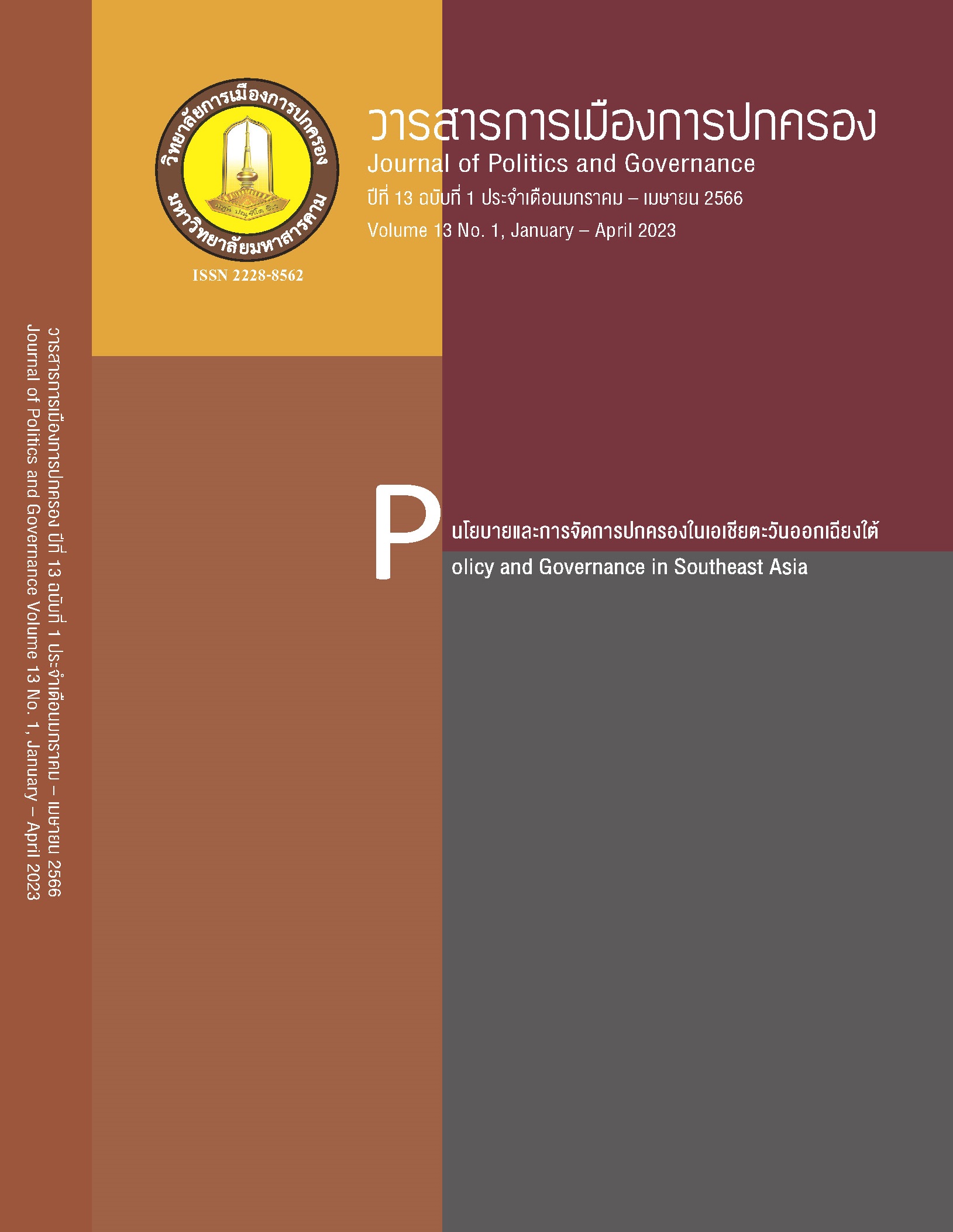The Implementation Covid-19 Crisis Management Policy in Thailand during the year 2020-2021
Main Article Content
Abstract
The objectives of this academic article are to analyze and discuss the implementation of the COVID-19 crisis management policy in Thailand and to recommend the policy development for the COVID-19 crisis management of Thailand. The data was investigated from research articles, academic articles, books, and websites related to the policy implementation and crisis management. The results were found that the first wave of implementation of the COVID-19 crisis management policy was successful due to the serious policy implementation and cooperation from the public, private and people sectors. On the contrary, in the second wave until the current wave, there were problems in policy implementation, due to unclear crisis communication and the government was unable to build confidence in solving the COVID-19 problems for the people. Recommendations for development the COVID-19 crisis management policy should be developed from three main stakeholders; government should communicate crisis information to the people quickly, accurately, and thoroughly; civil servants or policy makers should be enhanced in their crisis knowledge and management; and people should always be aware and emphasize that a crisis can happen at any time and no matter what kind of crisis. When these stakeholders give importance and awareness to crisis management, this will lead to the development of COVID-19 crisis management policy that are appropriate and can solve problems quickly and meet the needs of the people.
Article Details
References
กรมควบคุมโรค. (2565). สถานการณ์ผู้ติดเชื้อ COVID-19 อัพเดทรายวัน. สืบค้นจาก https://ddc.moph.go.th/covid19-dashboard/
กรมอนามัย. (2565). รายงานสถานการณ์วิกฤตโควิด-19 ทั่วโลก. สืบค้นเจาก https://covid19.anamai.moph.go.th/en/.
จุมพล หนิมพานิช. (2547). การวิเคราะห์นโยบาย: ขอบข่าย แนวคิด ทฤษฎี และกรณีตัวอย่าง. กรุงเทพฯ: โรงพิมพ์มหาวิทยาลัยสุโขทัยธรรมาธิราช.
รุ่งทิวา มากอิ่ม, ฐิติกร โตโพธิ์ไทย, และชมพูนุท โตโพธิ์ไทย. (2563). บทเรียนจากการป้องกันและควบคุมการระบาดของโควิด-19: กรณีศึกษาเทศบาลเมืองอ่างทอง. วารสารวิจัยระบบสาธารณสุข. 14(4), 489-507.
บัญชา เกิดมณี, สุรชัย ธรรมทวีธิกุล, ญาณพินิจ วชิรสุรงค์, บดินทร์ชาติ สุขบท, และสมบัติ ทีฆทรัพย์. (2563). แนวคิดและทิศทางการแก้ปัญหาโควิด-19. วารสารก้าวทันโลกวิทยาศาสตร์, 20(1), 1-12.
เรืองวิทย์ เกษสุวรรณ. (2551). การนำนโยบายไปปฏิบัติ. กรุงเทพฯ: บพิธการพิมพ์.
วรเดช จันทรศร (2556). ทฤษฎีการนำนโยบายสาธารณะไปปฏิบัติ (พิมพ์ครั้งที่ 6). กรุงเทพฯ: พริกหวานกราฟฟิค.
สมพร เฟื่องจันทร์. (2552). นโยบายสาธารณะ: ทฤษฎีและการปฏิบัติ. กรุงเทพฯ: ออน อาร์ต ครีเอชั่น.
สุมาลี จุทอง. (2562). การจัดการภัยพิบัติโรคระบาดโควิด 19 ในพื้นที่ชุมชนริมคลองหัวหมากน้อย สำนักงานเขตบางกะปิ. (การค้นคว้าอิสระหลักสูตรรัฐประศาสนศาสตรมหาบัณฑิต). มหาวิทยาลัยรามคำแหง.
สุรเดช สำรำญจิตต์, และมิ่งขวัญ ศิริโชติ. (2563). ความสัมพันธ์ระหว่างการรับรู้และพฤติกรรมการป้องกันโรคติดเชื้อไวรัสโคโรนา 2019 (COVID-19) ของผู้ใช้บริการ “ตลาดหลังราม” ซอยรามคาแหง 24 แยก 12-16. วารสารวิชาการสถาบันวิทยาการจัดการแห่งแปซิฟิค, 6(3), 401-411.
สำนักงานเลขาธิการสภาผู้แทนราษฎร. (2563). สรุปมาตรการและการดำเนินงานของไทยต่อสถานการณ์การแพร่ระบาดของโรคติดเชื้อไวรัสโคโรนา ๒๐๑๙. สืบค้นเมื่อวันที่ 1 สิงหาคม 2564, จาก https:// www.parliament.go.th/ewtadmin/ewt/parliament_parcy/ewt_dl_link.php?nid=69274.
เอราวัณ ฤกษ์ชัย (2563). การนำนโยบายป้องกันโรคติดเชื้อไวรัสโคโรนา 2019 (โควิด 19) ไปปฏิบัติกรณีศึกษาองค์การบริหารส่วนตำบลลำไทร อำเภอวังน้อย จังหวัดพระนครศรีอยุธยา. (การค้นคว้าอิสระหลักสูตรรัฐประศาสนศาสตรมหาบัณฑิต). มหาวิทยาลัยรามคาแหง.
Bowers, M. R., Hall, J. R., & Srinivasan, M. M. (2017). Organization culture and leadership style: The missing combination for selecting the right leader for effective crisis management. Business Horizons, 60(4), 551-563.
Bhuyan, A., Jorgensen, A., & Sharma, S. (2010). Taking the pulse of policy: The policy Implementation assessment tool. Washington, DC: Futures Group, Health Policy Initiative, Task Order 1.
Christensen, T., & Lægreid, P. (2020). The coronavirus crisis—crisis communication, meaning-making, and reputation management. International Public Management Journal, 23(5), 1-17.
Coombs, W. T. (2007). Ongoing crisis communication planning, managing, and responding. United States of America: Sage Publications.
Crandall, W. R., Parnell, J. A., & Spillan, J. E. (2014). Crisis Management: Leading in the New Strategy Landscape. 2nded. United States of America: SAGE.
Devlin, E. S. (2007). Crisis management planning and execution. United States of America: Auerbach Publications.
Dwiedienawati, D., Tjahjana, D., Faisal M., Gandasari, D., & Abdinagoro, S. B. (2021). Determinants of perceived effectiveness in crisis management and company reputation during the COVID-19 pandemic. Cogent Business & Management, 8(1), 1-22.
Jung Ki, E., & Nekmat, E. (2014). Situational crisis communication and interactivity: Usage and effectiveness of Facebook for crisis management by Fortune 500 companies. Computers in Human Behavior, 35, 140–147.
Kienzle, J., Guelfi, N., & Mustafiz, S. (2010). Crisis management systems: A case study for aspect-oriented modeling. In Katz S., Mezini M., & Kienzle, J. (Eds.), Transactions On Aspect-oriented Software Development VII. (pp. 1-22) Berlin: Springer.
Kingdon, J. W. (1993). How do issues get on public policy agendas.? In Wilson, W. J.
(Eds.), Sociology and the public agenda. (pp. 40-50). Retrieved from https://dx.doi.org/10.4135/9781483325484.n3.
Lukić, J., Jaganjac, J., & Lazarević, S. (2020). The successfulness of crisis management teams’ response to the crisis caused by the COVID 19 pandemic. Retrieved from https://www.ses.org.rs/uploads/lukic_et_al_210203_185812_741.pdf
Lockwood, N. R. (2005). Crisis management in today’s business environment: HR’s strategic Role. USA: SHRM Research Department.
Madigan, M. L. (2018). Handbook of emergency management concepts: A step-by-step approach. Great Britain: CRC Press.
Mazmanian, D. A., & Sabatier, P. A. (1989). Implementation and Public Policy with a New Perspective. Retrieved from http://www.des.ucdavis.edu/Faculty/Sabatier/ mazmaniansabatier.pdf
McGuire, D., Cunningham, J. E. A., Reynolds, K., & Matthews-Smith, G. (2020). Beating the virus: An examination of the crisis communication approach taken by New Zealand Prime Minister Jacinda Ardern during the Covid-19 pandemic. Human Resource
Development International, 23(4), 361-379.
Mthethwa, R. M., (2012). Critical dimensions for policy implementation. African Journal of Public Affairs, 5(2), 36-47.
Mubaroka, S., Zauhara, S., Setyowatia, E., & Suryadia, (2020). Policy implementation analysis: Exploration of George Edward III, Marilee S Grindle, and Mazmanian and Sabatier theories in the policy analysis triangle framework. Journal of Public
Administration Studies, 5(1), 33-38.
Pearson, C. M., & Clair, J. A. (1998). Reframing crisis management. Academy of Management Review, 23(1), 59-76.
Pressman, J. L., & Wildavsky, A. (1973). Implementation. Berkeley, CA: University of California Press.
Taneja, S., Pryor, M. G., Sewell, S., & Recuero, A. M. (2014). Strategic crisis management: A basis for renewal and crisis prevention. Journal of Management Policy and Practice, 15(1), 78-85.
Tekin, Ö. F. (2014). Importance of crisis management for public administration: The practice in Turkish public administration. The 2014 WEI (West East Institute) International Academic Conference Proceedings, pp.163-171, Budapest, Hungary.
Ulmer, R. R., Sellow, T. L., & Seeger, M. W. (2011). Effective Crisis Communication: Moving from Crisis to Opportunity. 2nded. United Stated of America: SAGE Publication Ltd.
Van Meter, D. S., & Van Horn, C. E. (1975). The policy implementation process: A conceptual framework. Administration & Society, 6(4), 445-488.
Wang, J. C., Chun, Y. Ng., & Brook, R. H. (2020). Response to COVID-19 in Taiwan: Big Data Analytics, New Technology, and Proactive Testing. Retrieved from https://smnyct. org/index.php/descargar/adjunto/504_ttT4Od_pdf
Worldometers. (2022). Reported Cases and Deaths by Country or Territory. Retrieved from https://www.worldometers.info/coronavirus/?fbclid=IwAR1ux8F24Rme7fl38zRE_ QGdgM_lnfVYr-s59j3z3wziPbv774_vSdeiTDA


